HRM302 Managing Change: Strategies, Roles, and Assessment Report
VerifiedAdded on 2023/05/28
|8
|1930
|343
Report
AI Summary
This report addresses three key questions related to change management. Firstly, it explores strategies to mitigate resistance to change, emphasizing communication, employee engagement, and training. Secondly, it examines the roles of leaders and change agents in the change management process, highlighting their responsibilities in clarifying issues, building relationships, and facilitating communication. Finally, the report discusses various methods for assessing the success of change management strategies, including employee feedback, 360-degree feedback, balanced scorecards, and one-on-one sessions. The analysis draws upon academic research and provides practical insights into effective change management practices, referencing key concepts from the provided assignment brief and relevant literature.

Managing change
Paraphrase This Document
Need a fresh take? Get an instant paraphrase of this document with our AI Paraphraser

1 | P a g e
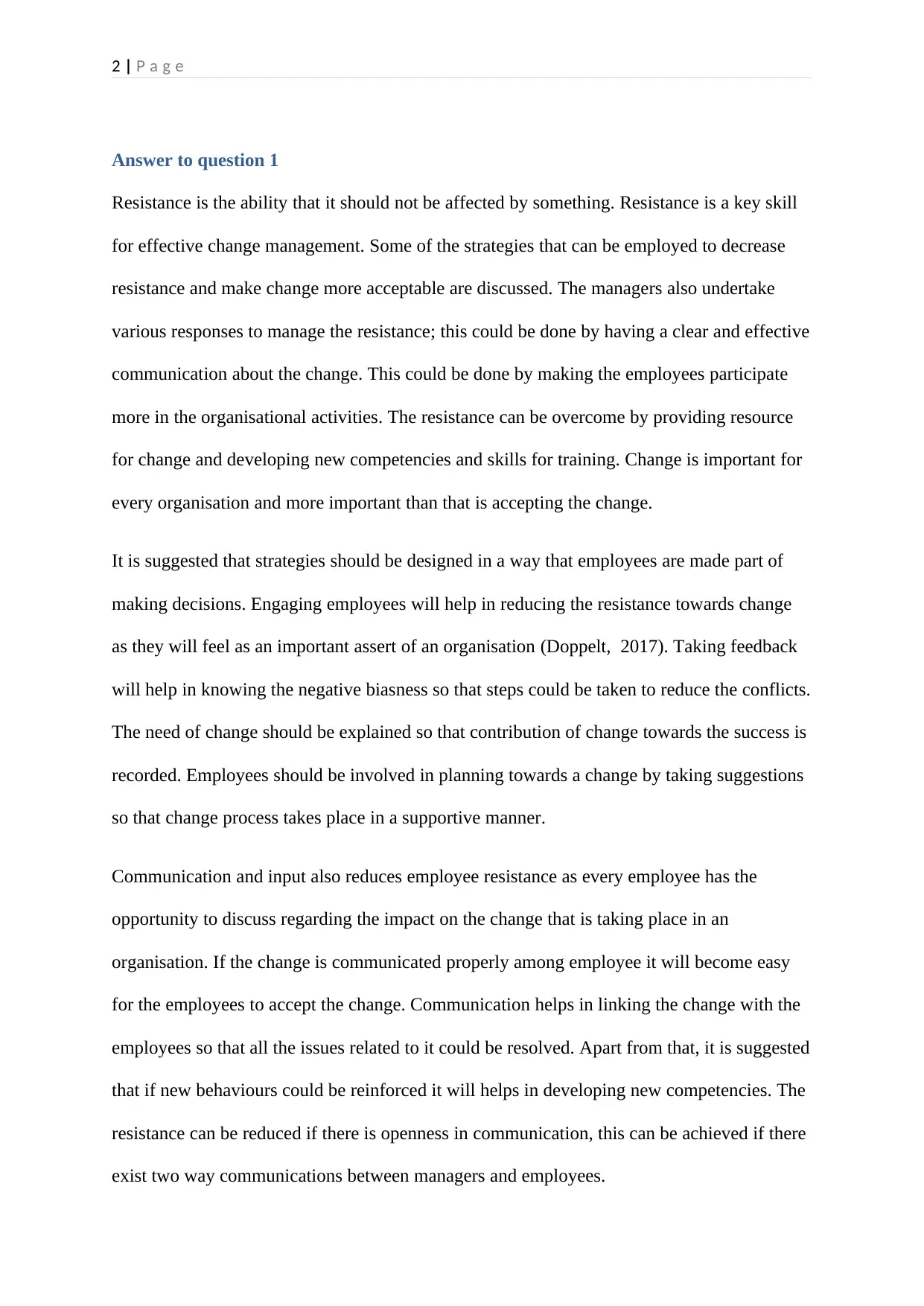
2 | P a g e
Answer to question 1
Resistance is the ability that it should not be affected by something. Resistance is a key skill
for effective change management. Some of the strategies that can be employed to decrease
resistance and make change more acceptable are discussed. The managers also undertake
various responses to manage the resistance; this could be done by having a clear and effective
communication about the change. This could be done by making the employees participate
more in the organisational activities. The resistance can be overcome by providing resource
for change and developing new competencies and skills for training. Change is important for
every organisation and more important than that is accepting the change.
It is suggested that strategies should be designed in a way that employees are made part of
making decisions. Engaging employees will help in reducing the resistance towards change
as they will feel as an important assert of an organisation (Doppelt, 2017). Taking feedback
will help in knowing the negative biasness so that steps could be taken to reduce the conflicts.
The need of change should be explained so that contribution of change towards the success is
recorded. Employees should be involved in planning towards a change by taking suggestions
so that change process takes place in a supportive manner.
Communication and input also reduces employee resistance as every employee has the
opportunity to discuss regarding the impact on the change that is taking place in an
organisation. If the change is communicated properly among employee it will become easy
for the employees to accept the change. Communication helps in linking the change with the
employees so that all the issues related to it could be resolved. Apart from that, it is suggested
that if new behaviours could be reinforced it will helps in developing new competencies. The
resistance can be reduced if there is openness in communication, this can be achieved if there
exist two way communications between managers and employees.
Answer to question 1
Resistance is the ability that it should not be affected by something. Resistance is a key skill
for effective change management. Some of the strategies that can be employed to decrease
resistance and make change more acceptable are discussed. The managers also undertake
various responses to manage the resistance; this could be done by having a clear and effective
communication about the change. This could be done by making the employees participate
more in the organisational activities. The resistance can be overcome by providing resource
for change and developing new competencies and skills for training. Change is important for
every organisation and more important than that is accepting the change.
It is suggested that strategies should be designed in a way that employees are made part of
making decisions. Engaging employees will help in reducing the resistance towards change
as they will feel as an important assert of an organisation (Doppelt, 2017). Taking feedback
will help in knowing the negative biasness so that steps could be taken to reduce the conflicts.
The need of change should be explained so that contribution of change towards the success is
recorded. Employees should be involved in planning towards a change by taking suggestions
so that change process takes place in a supportive manner.
Communication and input also reduces employee resistance as every employee has the
opportunity to discuss regarding the impact on the change that is taking place in an
organisation. If the change is communicated properly among employee it will become easy
for the employees to accept the change. Communication helps in linking the change with the
employees so that all the issues related to it could be resolved. Apart from that, it is suggested
that if new behaviours could be reinforced it will helps in developing new competencies. The
resistance can be reduced if there is openness in communication, this can be achieved if there
exist two way communications between managers and employees.
⊘ This is a preview!⊘
Do you want full access?
Subscribe today to unlock all pages.

Trusted by 1+ million students worldwide
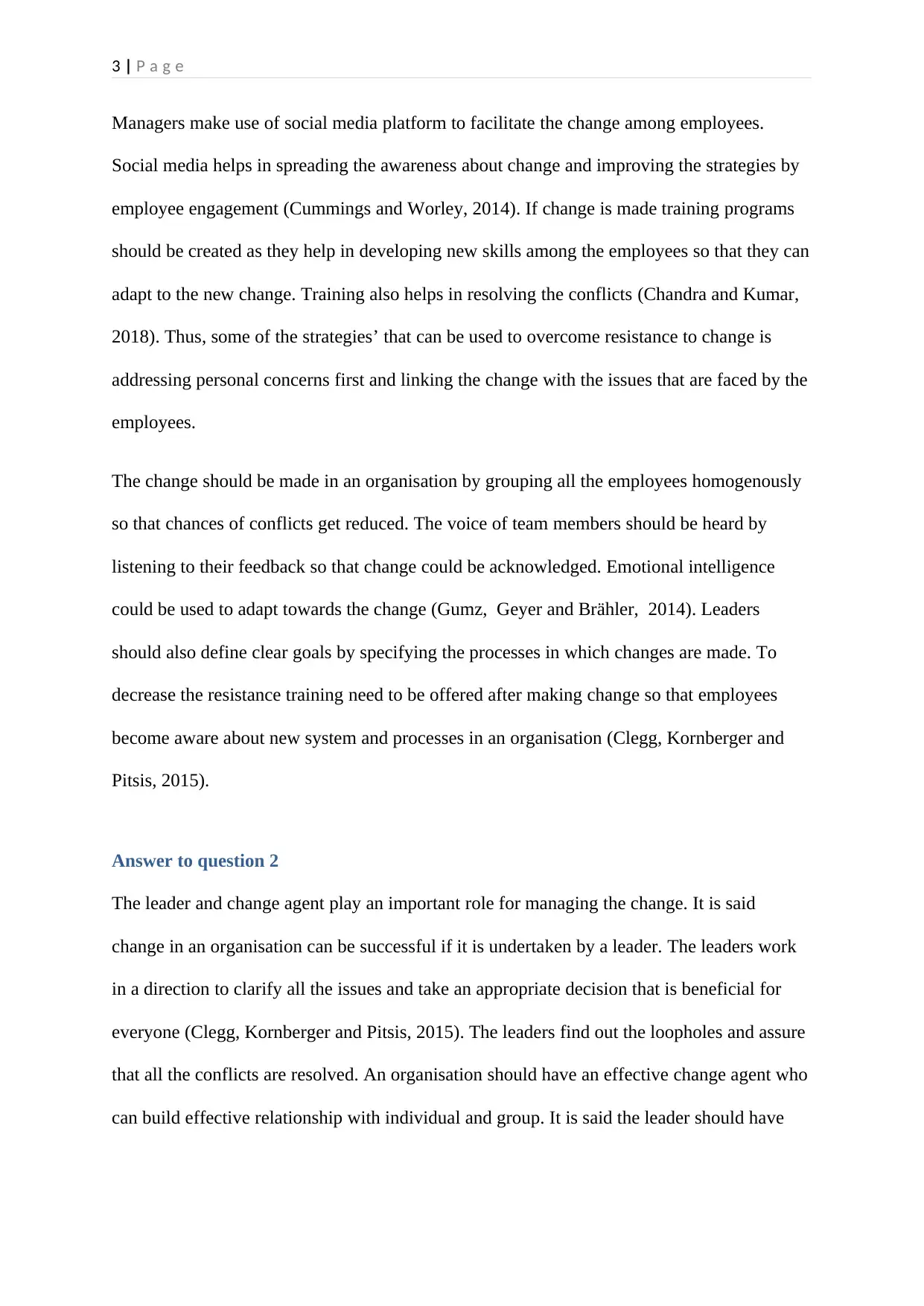
3 | P a g e
Managers make use of social media platform to facilitate the change among employees.
Social media helps in spreading the awareness about change and improving the strategies by
employee engagement (Cummings and Worley, 2014). If change is made training programs
should be created as they help in developing new skills among the employees so that they can
adapt to the new change. Training also helps in resolving the conflicts (Chandra and Kumar,
2018). Thus, some of the strategies’ that can be used to overcome resistance to change is
addressing personal concerns first and linking the change with the issues that are faced by the
employees.
The change should be made in an organisation by grouping all the employees homogenously
so that chances of conflicts get reduced. The voice of team members should be heard by
listening to their feedback so that change could be acknowledged. Emotional intelligence
could be used to adapt towards the change (Gumz, Geyer and Brähler, 2014). Leaders
should also define clear goals by specifying the processes in which changes are made. To
decrease the resistance training need to be offered after making change so that employees
become aware about new system and processes in an organisation (Clegg, Kornberger and
Pitsis, 2015).
Answer to question 2
The leader and change agent play an important role for managing the change. It is said
change in an organisation can be successful if it is undertaken by a leader. The leaders work
in a direction to clarify all the issues and take an appropriate decision that is beneficial for
everyone (Clegg, Kornberger and Pitsis, 2015). The leaders find out the loopholes and assure
that all the conflicts are resolved. An organisation should have an effective change agent who
can build effective relationship with individual and group. It is said the leader should have
Managers make use of social media platform to facilitate the change among employees.
Social media helps in spreading the awareness about change and improving the strategies by
employee engagement (Cummings and Worley, 2014). If change is made training programs
should be created as they help in developing new skills among the employees so that they can
adapt to the new change. Training also helps in resolving the conflicts (Chandra and Kumar,
2018). Thus, some of the strategies’ that can be used to overcome resistance to change is
addressing personal concerns first and linking the change with the issues that are faced by the
employees.
The change should be made in an organisation by grouping all the employees homogenously
so that chances of conflicts get reduced. The voice of team members should be heard by
listening to their feedback so that change could be acknowledged. Emotional intelligence
could be used to adapt towards the change (Gumz, Geyer and Brähler, 2014). Leaders
should also define clear goals by specifying the processes in which changes are made. To
decrease the resistance training need to be offered after making change so that employees
become aware about new system and processes in an organisation (Clegg, Kornberger and
Pitsis, 2015).
Answer to question 2
The leader and change agent play an important role for managing the change. It is said
change in an organisation can be successful if it is undertaken by a leader. The leaders work
in a direction to clarify all the issues and take an appropriate decision that is beneficial for
everyone (Clegg, Kornberger and Pitsis, 2015). The leaders find out the loopholes and assure
that all the conflicts are resolved. An organisation should have an effective change agent who
can build effective relationship with individual and group. It is said the leader should have
Paraphrase This Document
Need a fresh take? Get an instant paraphrase of this document with our AI Paraphraser
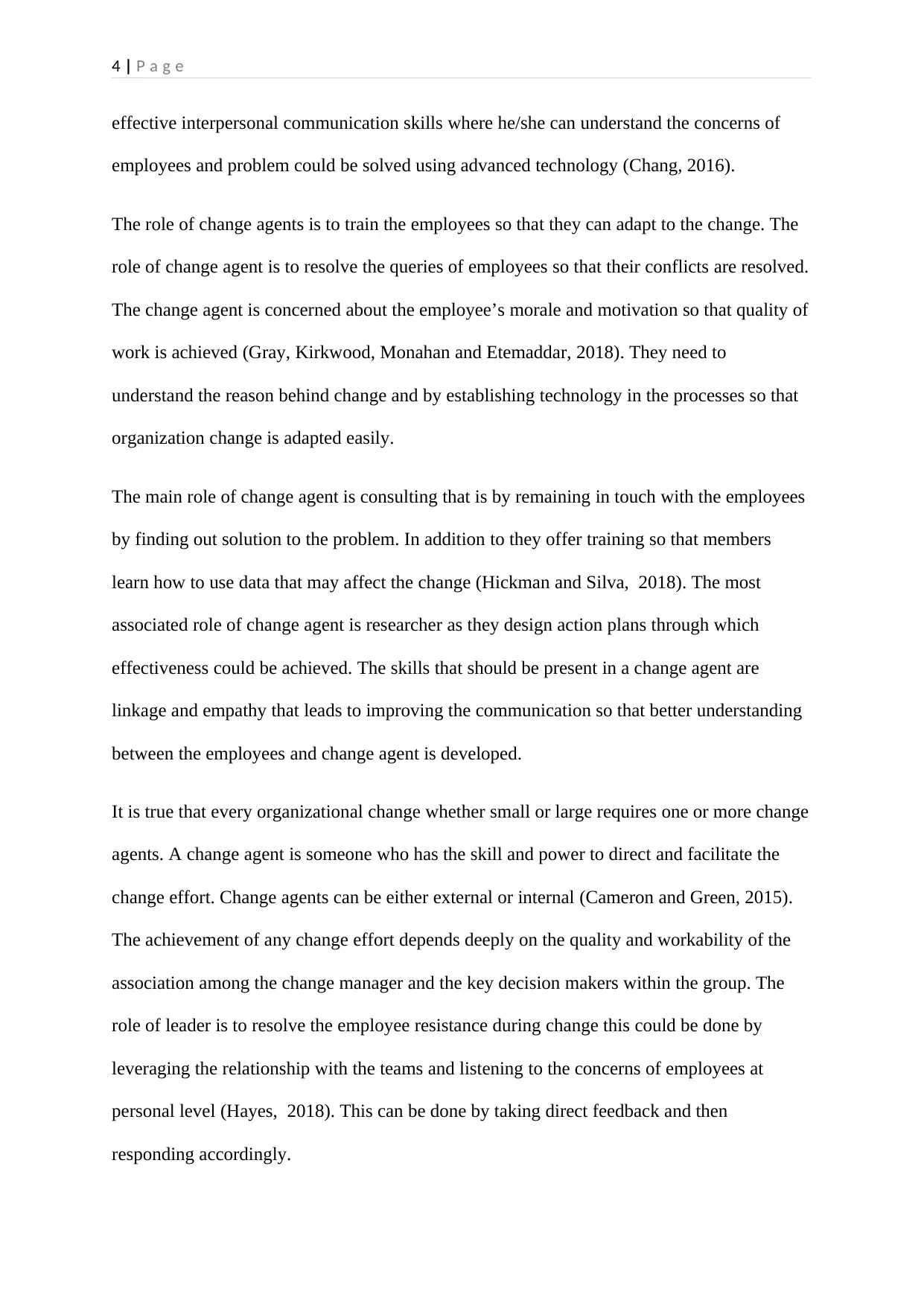
4 | P a g e
effective interpersonal communication skills where he/she can understand the concerns of
employees and problem could be solved using advanced technology (Chang, 2016).
The role of change agents is to train the employees so that they can adapt to the change. The
role of change agent is to resolve the queries of employees so that their conflicts are resolved.
The change agent is concerned about the employee’s morale and motivation so that quality of
work is achieved (Gray, Kirkwood, Monahan and Etemaddar, 2018). They need to
understand the reason behind change and by establishing technology in the processes so that
organization change is adapted easily.
The main role of change agent is consulting that is by remaining in touch with the employees
by finding out solution to the problem. In addition to they offer training so that members
learn how to use data that may affect the change (Hickman and Silva, 2018). The most
associated role of change agent is researcher as they design action plans through which
effectiveness could be achieved. The skills that should be present in a change agent are
linkage and empathy that leads to improving the communication so that better understanding
between the employees and change agent is developed.
It is true that every organizational change whether small or large requires one or more change
agents. A change agent is someone who has the skill and power to direct and facilitate the
change effort. Change agents can be either external or internal (Cameron and Green, 2015).
The achievement of any change effort depends deeply on the quality and workability of the
association among the change manager and the key decision makers within the group. The
role of leader is to resolve the employee resistance during change this could be done by
leveraging the relationship with the teams and listening to the concerns of employees at
personal level (Hayes, 2018). This can be done by taking direct feedback and then
responding accordingly.
effective interpersonal communication skills where he/she can understand the concerns of
employees and problem could be solved using advanced technology (Chang, 2016).
The role of change agents is to train the employees so that they can adapt to the change. The
role of change agent is to resolve the queries of employees so that their conflicts are resolved.
The change agent is concerned about the employee’s morale and motivation so that quality of
work is achieved (Gray, Kirkwood, Monahan and Etemaddar, 2018). They need to
understand the reason behind change and by establishing technology in the processes so that
organization change is adapted easily.
The main role of change agent is consulting that is by remaining in touch with the employees
by finding out solution to the problem. In addition to they offer training so that members
learn how to use data that may affect the change (Hickman and Silva, 2018). The most
associated role of change agent is researcher as they design action plans through which
effectiveness could be achieved. The skills that should be present in a change agent are
linkage and empathy that leads to improving the communication so that better understanding
between the employees and change agent is developed.
It is true that every organizational change whether small or large requires one or more change
agents. A change agent is someone who has the skill and power to direct and facilitate the
change effort. Change agents can be either external or internal (Cameron and Green, 2015).
The achievement of any change effort depends deeply on the quality and workability of the
association among the change manager and the key decision makers within the group. The
role of leader is to resolve the employee resistance during change this could be done by
leveraging the relationship with the teams and listening to the concerns of employees at
personal level (Hayes, 2018). This can be done by taking direct feedback and then
responding accordingly.
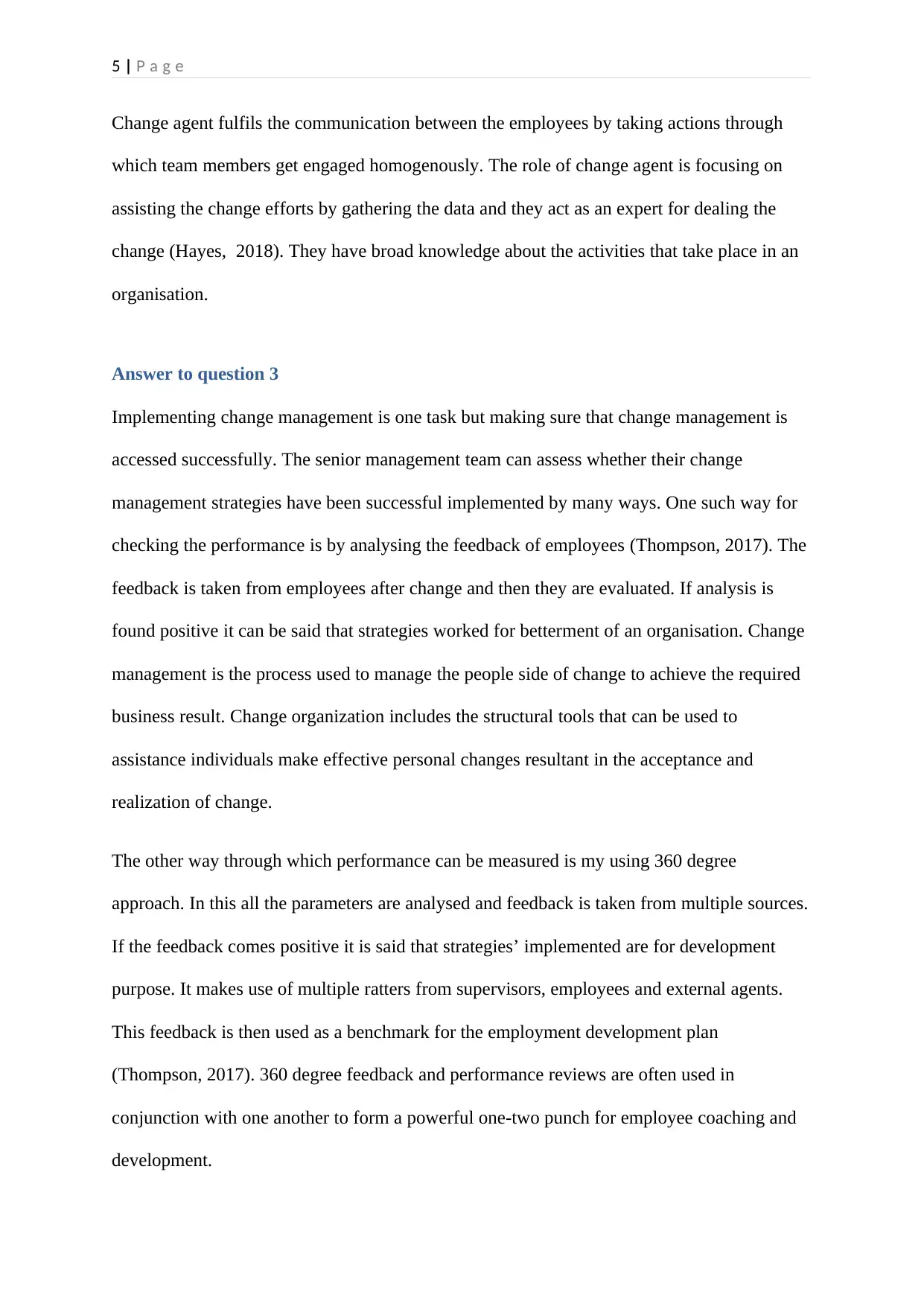
5 | P a g e
Change agent fulfils the communication between the employees by taking actions through
which team members get engaged homogenously. The role of change agent is focusing on
assisting the change efforts by gathering the data and they act as an expert for dealing the
change (Hayes, 2018). They have broad knowledge about the activities that take place in an
organisation.
Answer to question 3
Implementing change management is one task but making sure that change management is
accessed successfully. The senior management team can assess whether their change
management strategies have been successful implemented by many ways. One such way for
checking the performance is by analysing the feedback of employees (Thompson, 2017). The
feedback is taken from employees after change and then they are evaluated. If analysis is
found positive it can be said that strategies worked for betterment of an organisation. Change
management is the process used to manage the people side of change to achieve the required
business result. Change organization includes the structural tools that can be used to
assistance individuals make effective personal changes resultant in the acceptance and
realization of change.
The other way through which performance can be measured is my using 360 degree
approach. In this all the parameters are analysed and feedback is taken from multiple sources.
If the feedback comes positive it is said that strategies’ implemented are for development
purpose. It makes use of multiple ratters from supervisors, employees and external agents.
This feedback is then used as a benchmark for the employment development plan
(Thompson, 2017). 360 degree feedback and performance reviews are often used in
conjunction with one another to form a powerful one-two punch for employee coaching and
development.
Change agent fulfils the communication between the employees by taking actions through
which team members get engaged homogenously. The role of change agent is focusing on
assisting the change efforts by gathering the data and they act as an expert for dealing the
change (Hayes, 2018). They have broad knowledge about the activities that take place in an
organisation.
Answer to question 3
Implementing change management is one task but making sure that change management is
accessed successfully. The senior management team can assess whether their change
management strategies have been successful implemented by many ways. One such way for
checking the performance is by analysing the feedback of employees (Thompson, 2017). The
feedback is taken from employees after change and then they are evaluated. If analysis is
found positive it can be said that strategies worked for betterment of an organisation. Change
management is the process used to manage the people side of change to achieve the required
business result. Change organization includes the structural tools that can be used to
assistance individuals make effective personal changes resultant in the acceptance and
realization of change.
The other way through which performance can be measured is my using 360 degree
approach. In this all the parameters are analysed and feedback is taken from multiple sources.
If the feedback comes positive it is said that strategies’ implemented are for development
purpose. It makes use of multiple ratters from supervisors, employees and external agents.
This feedback is then used as a benchmark for the employment development plan
(Thompson, 2017). 360 degree feedback and performance reviews are often used in
conjunction with one another to form a powerful one-two punch for employee coaching and
development.
⊘ This is a preview!⊘
Do you want full access?
Subscribe today to unlock all pages.

Trusted by 1+ million students worldwide
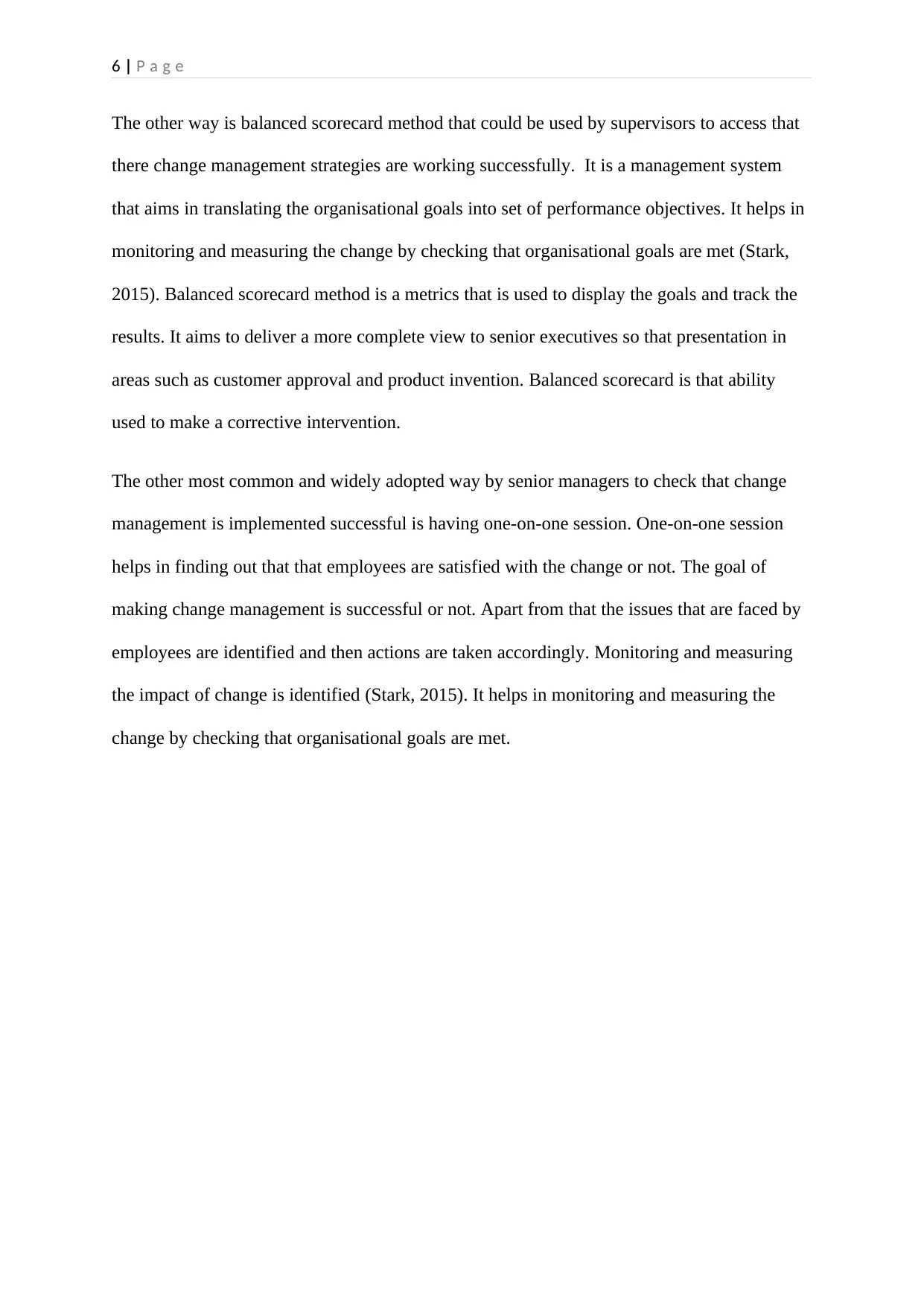
6 | P a g e
The other way is balanced scorecard method that could be used by supervisors to access that
there change management strategies are working successfully. It is a management system
that aims in translating the organisational goals into set of performance objectives. It helps in
monitoring and measuring the change by checking that organisational goals are met (Stark,
2015). Balanced scorecard method is a metrics that is used to display the goals and track the
results. It aims to deliver a more complete view to senior executives so that presentation in
areas such as customer approval and product invention. Balanced scorecard is that ability
used to make a corrective intervention.
The other most common and widely adopted way by senior managers to check that change
management is implemented successful is having one-on-one session. One-on-one session
helps in finding out that that employees are satisfied with the change or not. The goal of
making change management is successful or not. Apart from that the issues that are faced by
employees are identified and then actions are taken accordingly. Monitoring and measuring
the impact of change is identified (Stark, 2015). It helps in monitoring and measuring the
change by checking that organisational goals are met.
The other way is balanced scorecard method that could be used by supervisors to access that
there change management strategies are working successfully. It is a management system
that aims in translating the organisational goals into set of performance objectives. It helps in
monitoring and measuring the change by checking that organisational goals are met (Stark,
2015). Balanced scorecard method is a metrics that is used to display the goals and track the
results. It aims to deliver a more complete view to senior executives so that presentation in
areas such as customer approval and product invention. Balanced scorecard is that ability
used to make a corrective intervention.
The other most common and widely adopted way by senior managers to check that change
management is implemented successful is having one-on-one session. One-on-one session
helps in finding out that that employees are satisfied with the change or not. The goal of
making change management is successful or not. Apart from that the issues that are faced by
employees are identified and then actions are taken accordingly. Monitoring and measuring
the impact of change is identified (Stark, 2015). It helps in monitoring and measuring the
change by checking that organisational goals are met.
Paraphrase This Document
Need a fresh take? Get an instant paraphrase of this document with our AI Paraphraser
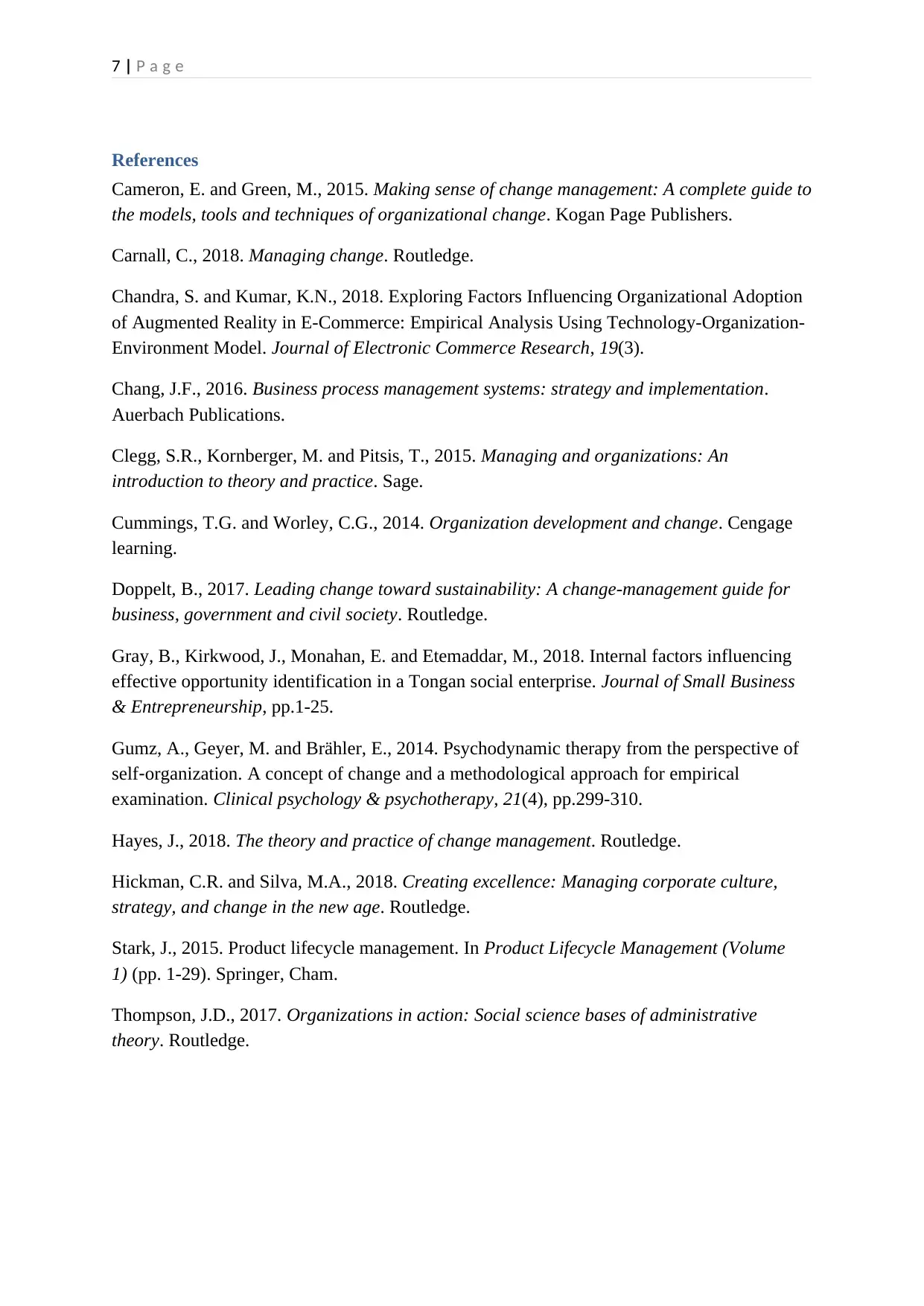
7 | P a g e
References
Cameron, E. and Green, M., 2015. Making sense of change management: A complete guide to
the models, tools and techniques of organizational change. Kogan Page Publishers.
Carnall, C., 2018. Managing change. Routledge.
Chandra, S. and Kumar, K.N., 2018. Exploring Factors Influencing Organizational Adoption
of Augmented Reality in E-Commerce: Empirical Analysis Using Technology-Organization-
Environment Model. Journal of Electronic Commerce Research, 19(3).
Chang, J.F., 2016. Business process management systems: strategy and implementation.
Auerbach Publications.
Clegg, S.R., Kornberger, M. and Pitsis, T., 2015. Managing and organizations: An
introduction to theory and practice. Sage.
Cummings, T.G. and Worley, C.G., 2014. Organization development and change. Cengage
learning.
Doppelt, B., 2017. Leading change toward sustainability: A change-management guide for
business, government and civil society. Routledge.
Gray, B., Kirkwood, J., Monahan, E. and Etemaddar, M., 2018. Internal factors influencing
effective opportunity identification in a Tongan social enterprise. Journal of Small Business
& Entrepreneurship, pp.1-25.
Gumz, A., Geyer, M. and Brähler, E., 2014. Psychodynamic therapy from the perspective of
self‐organization. A concept of change and a methodological approach for empirical
examination. Clinical psychology & psychotherapy, 21(4), pp.299-310.
Hayes, J., 2018. The theory and practice of change management. Routledge.
Hickman, C.R. and Silva, M.A., 2018. Creating excellence: Managing corporate culture,
strategy, and change in the new age. Routledge.
Stark, J., 2015. Product lifecycle management. In Product Lifecycle Management (Volume
1) (pp. 1-29). Springer, Cham.
Thompson, J.D., 2017. Organizations in action: Social science bases of administrative
theory. Routledge.
References
Cameron, E. and Green, M., 2015. Making sense of change management: A complete guide to
the models, tools and techniques of organizational change. Kogan Page Publishers.
Carnall, C., 2018. Managing change. Routledge.
Chandra, S. and Kumar, K.N., 2018. Exploring Factors Influencing Organizational Adoption
of Augmented Reality in E-Commerce: Empirical Analysis Using Technology-Organization-
Environment Model. Journal of Electronic Commerce Research, 19(3).
Chang, J.F., 2016. Business process management systems: strategy and implementation.
Auerbach Publications.
Clegg, S.R., Kornberger, M. and Pitsis, T., 2015. Managing and organizations: An
introduction to theory and practice. Sage.
Cummings, T.G. and Worley, C.G., 2014. Organization development and change. Cengage
learning.
Doppelt, B., 2017. Leading change toward sustainability: A change-management guide for
business, government and civil society. Routledge.
Gray, B., Kirkwood, J., Monahan, E. and Etemaddar, M., 2018. Internal factors influencing
effective opportunity identification in a Tongan social enterprise. Journal of Small Business
& Entrepreneurship, pp.1-25.
Gumz, A., Geyer, M. and Brähler, E., 2014. Psychodynamic therapy from the perspective of
self‐organization. A concept of change and a methodological approach for empirical
examination. Clinical psychology & psychotherapy, 21(4), pp.299-310.
Hayes, J., 2018. The theory and practice of change management. Routledge.
Hickman, C.R. and Silva, M.A., 2018. Creating excellence: Managing corporate culture,
strategy, and change in the new age. Routledge.
Stark, J., 2015. Product lifecycle management. In Product Lifecycle Management (Volume
1) (pp. 1-29). Springer, Cham.
Thompson, J.D., 2017. Organizations in action: Social science bases of administrative
theory. Routledge.
1 out of 8